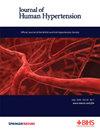A new approach to interpreting the LF/HF ratio: a study in hypertensive patients
IF 3.4
4区 医学
Q2 PERIPHERAL VASCULAR DISEASE
引用次数: 0
Abstract
Resistant arterial hypertension (RHTN) has been associated with sympathetic hyperactivity, which represents a significant challenge in the management and treatment of arterial hypertension. In the present study, autonomic modulation was analysed in hypertensive, resistant hypertensive, and refractory hypertensive patients, compared to a group of apparently healthy normotensive individuals. Participants with resistant hypertension were included only after the exclusion of secondary hypertension and pseudo-resistance diagnoses. Heart rate variability (HRV) analysis included parameters from the time domain, frequency domain, and nonlinear methods, providing a comprehensive assessment of global autonomic modulation. The results demonstrated a significant reduction in global HRV across all three hypertensive groups, evidenced by decreases in parameters from the time domain, frequency domain and nonlinear methods. Furthermore, a concomitant reduction in the low- and high-frequency components was observed, with the decrease in the high-frequency component being more pronounced. These findings challenge the traditional view of isolated sympathetic hyperactivity in hypertension. Instead, the results reveal a relative predominance of sympathetic function due to the more marked attenuation of parasympathetic activity. These results underscore the need to reinterpret autonomic dysfunction in arterial hypertension, particularly in its more severe forms, as a global loss of autonomic modulation.

解读LF/HF比值的新方法:一项高血压患者的研究。
顽固性动脉高血压(RHTN)与交感神经亢进有关,这是动脉高血压管理和治疗的一个重大挑战。在本研究中,我们分析了高血压、顽固性高血压和难治性高血压患者的自主神经调节,并与一组明显健康的正常血压个体进行了比较。只有在排除继发性高血压和假抵抗诊断后,才纳入顽固性高血压患者。心率变异性(HRV)分析包括时域、频域和非线性方法的参数,提供了对全局自主调节的综合评估。结果显示,所有三组高血压患者的整体HRV均显著降低,时域、频域和非线性方法的参数均有所降低。此外,观察到伴随的低频和高频成分的减少,高频成分的减少更为明显。这些发现挑战了高血压孤立交感神经亢进的传统观点。相反,结果显示交感功能的相对优势是由于副交感神经活动更明显的衰减。这些结果强调需要重新解释动脉高血压的自主神经功能障碍,特别是在其更严重的形式下,作为自主调节的全局丧失。
本文章由计算机程序翻译,如有差异,请以英文原文为准。
求助全文
约1分钟内获得全文
求助全文
来源期刊

Journal of Human Hypertension
医学-外周血管病
CiteScore
5.20
自引率
3.70%
发文量
126
审稿时长
6-12 weeks
期刊介绍:
Journal of Human Hypertension is published monthly and is of interest to health care professionals who deal with hypertension (specialists, internists, primary care physicians) and public health workers. We believe that our patients benefit from robust scientific data that are based on well conducted clinical trials. We also believe that basic sciences are the foundations on which we build our knowledge of clinical conditions and their management. Towards this end, although we are primarily a clinical based journal, we also welcome suitable basic sciences studies that promote our understanding of human hypertension.
The journal aims to perform the dual role of increasing knowledge in the field of high blood pressure as well as improving the standard of care of patients. The editors will consider for publication all suitable papers dealing directly or indirectly with clinical aspects of hypertension, including but not limited to epidemiology, pathophysiology, therapeutics and basic sciences involving human subjects or tissues. We also consider papers from all specialties such as ophthalmology, cardiology, nephrology, obstetrics and stroke medicine that deal with the various aspects of hypertension and its complications.
 求助内容:
求助内容: 应助结果提醒方式:
应助结果提醒方式:


